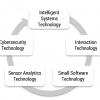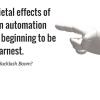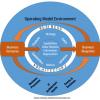Business Transformation Requires Transformational Leaders
Leadership and teaming skills are front and center in times of rapid change. Meet today’s constant disruption head on with expert guidance in leadership, business strategy, transformation, and innovation. Whether the disruption du jour is a digitally-driven upending of traditional business models, the pandemic-driven end to business as usual, or the change-driven challenge of staffing that meets your transformation plans—you’ll be prepared with cutting edge techniques and expert knowledge that enable strategic leadership.
Recently Published
There has scarcely been a day the past few years in which there hasn’t been a breathless press release or article touting some new technological advance and how it will “literally change the world as we know it — forever.” We’ve seen in quick succession big data, 3D printing, and the Internet of Things (IoT), to mention just a few, given the mantle of being the next big societal revolutionary change agent.
Every year pundits, hardware vendors, software vendors, consultancies, academics, and even government agencies publish their technology “picks” for the following year. One cannot help but notice that just about all of the lists identify the usual suspects; cloud computing, AI, predictive analytics, wearables, and augmented reality are among about five others that make nearly everyone’s “Top 10.”
The approach I take here is a little different. I look at clusters of technologies. I do this because of the overlap among the usual suspects and because of the interrelationships among the technologies. The identification of clusters is also useful because it acknowledges the interdependencies among technologies as well as the integration and interoperability required to optimize whole technology clusters and meaningfully impact business rules, processes, and models. In other words, it’s operationally impossible to acquire, pilot, deploy, and support technologies individually because they’re always dependent upon each other and always connected.
A Lean management system encourages those closest to the customer, those who best understand the work, to own their processes, solve their problems, and make their own improvements and innovations, guided by the strategic priorities of the overall organization.
The Coming Backlash Boom?
The societal effects of AI-driven automation and the like are just beginning to be felt in earnest. The one thing that seems to be certain: over the next decades, companies and countries should be preparing for more political risk and uncertainty, and revamp their enterprise risk management approaches accordingly.
With EA, organization leaders can more readily improve the effectiveness, efficiency, and responsiveness of their enterprise. Effective EA is the key to enabling the enterprise to address orders-of-magnitude increases in complexity and orders-of-magnitude increases in the rate of change.
Security Architecture and Design
From the design and development of individual applications to enterprise network architecture, our approach is to make security an integral part of the finished product, ensure it is cost-effective and acceptable to your employees, and that it differentiates your products from those of your competition.
There is significant potential value for companies of all sizes in reviewing their potential financial vulnerability in the case of a cyberattack, as well as determining whether purchasing (or increasing their) cyber insurance could provide the protection to keep them in business.
Business architecture provides a holistic business perspective of a business ecosystem based on a clearly defined, time-tested framework. Core business architecture domains include capabilities, value streams, information, and organization. The extended view of business architecture includes strategies and policies that drive actions and investments, external and internal stakeholders that receive and participate in value delivery, the products and services a business delivers, the initiatives in which a business invests, and the metrics that enable business performance management.
















